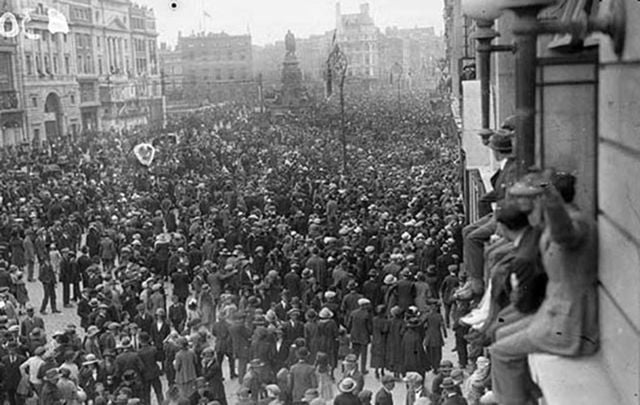Politics
Half a Million Mourners Honor Michael Collins at Dublin Funeral

On August 28, 1922, an estimated 500,000 people gathered in Dublin to pay their respects at the funeral of Irish revolutionary leader Michael Collins. This event drew nearly one-fifth of the population of Ireland, showcasing the profound impact Collins had on the nation following his assassination just days earlier on August 22 during an ambush in County Cork. The outpouring of grief highlighted Collins’s status as a national hero, known for his pivotal role in the fight for Irish independence and his work in establishing the Irish Free State.
As the funeral procession made its way through Dublin, crowds lined Sackville Street—now known as O’Connell Street—offering a final tribute to “The Big Fellow.” Thousands attended the ceremony held at Dublin’s Pro Cathedral, which included both Irish and international dignitaries. Collins’s death had been a significant blow to the republican cause, and the public’s mourning reflected the deep sense of loss felt across the country.
Born in 1890 in County Cork, Michael Collins emerged as a key figure in the Irish republican movement. He served as an aide-de-camp to Joseph Plunkett during the 1916 Easter Rising and was subsequently imprisoned in Frongoch, Wales. Upon his return to Ireland, Collins quickly rose to prominence, particularly after the execution of many top figures in the republican leadership following the Rising.
In 1919, he was appointed Minister of Finance by Eamon de Valera, further solidifying his influence within the movement. Collins played a crucial role in the War of Independence as the Director of Intelligence for the Irish Republican Army (IRA). He organized a special unit known as The Squad, responsible for targeting British agents and informers during the conflict.
Collins’s strategic acumen was evident when he became one of the Irish delegates who negotiated the Anglo-Irish Treaty in 1921. This agreement led to the establishment of the Irish Free State and the partition of Ireland, a process that Collins supported despite the personal cost. He famously remarked that signing the treaty felt like signing his own death warrant.
Tragically, Collins was killed during the ensuing Civil War, ambushed by anti-Treaty forces while traveling through Beal na mBlath, County Cork. He was convinced that he would be safe in his home territory, but the ambush resulted in a fatal gunshot wound to the head. It is believed that he was shot by Dennis O’Neill, a fellow Corkman and former member of the British Army during World War I.
Following his death, Collins’s body was transported by sea from Cork to Dublin and lay in state for three days at Dublin City Hall. Mourners included not only republicans but also former British soldiers who came to pay their respects. The scale of the funeral was unprecedented, marking one of the largest public gatherings in Irish history.
Collins was finally laid to rest in Glasnevin Cemetery, where he is interred alongside other national heroes. His funeral remains the largest in the history of the cemetery, and his grave continues to attract visitors, with tributes and flowers frequently left at his final resting place.
The legacy of Michael Collins endures, as evidenced by the ongoing remembrance of his contributions to Irish independence. The events of August 28, 1922, serve as a poignant reminder of his lasting impact on the nation and the sacrifices made during the struggle for freedom.
-

 Top Stories3 months ago
Top Stories3 months agoTributes Surge for 9-Year-Old Leon Briody After Cancer Battle
-

 Entertainment4 months ago
Entertainment4 months agoAimee Osbourne Joins Family for Emotional Tribute to Ozzy
-

 Politics4 months ago
Politics4 months agoDanny Healy-Rae Considers Complaint After Altercation with Garda
-

 Top Stories4 months ago
Top Stories4 months agoIreland Enjoys Summer Heat as Hurricane Erin Approaches Atlantic
-

 World5 months ago
World5 months agoHawaii Commemorates 80 Years Since Hiroshima Bombing with Ceremony
-

 Top Stories3 months ago
Top Stories3 months agoNewcastle West Woman Patricia Foley Found Safe After Urgent Search
-

 Top Stories5 months ago
Top Stories5 months agoFianna Fáil TDs Urgently Consider Maire Geoghegan-Quinn for Presidency
-

 World5 months ago
World5 months agoCouple Convicted of Murdering Two-Year-Old Grandson in Wales
-

 World5 months ago
World5 months agoGaza Aid Distribution Tragedy: 20 Killed Amid Ongoing Violence
-

 World5 months ago
World5 months agoAristocrat Constance Marten and Partner Convicted of Infant Murder
-

 Top Stories4 months ago
Top Stories4 months agoClimbing Errigal: A Must-Do Summer Adventure in Donegal
-

 Top Stories4 months ago
Top Stories4 months agoHike Donegal’s Errigal Mountain NOW for Unforgettable Summer Views









